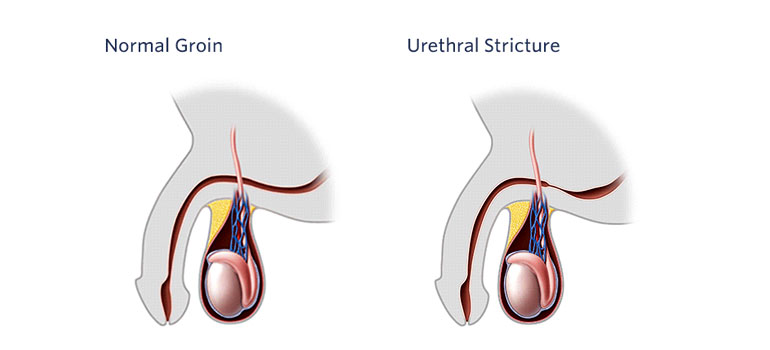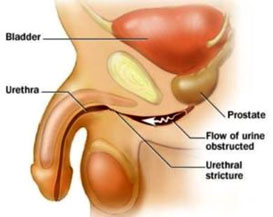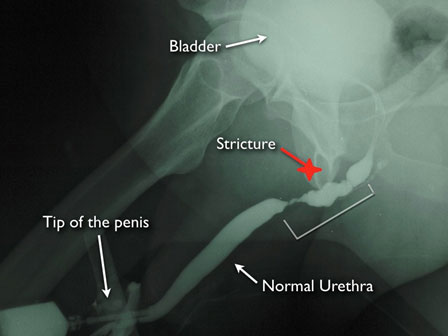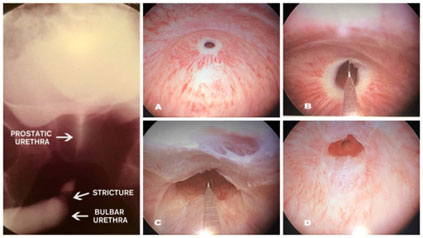
Urethral Stricture is a disease that causes narrowing of the tube that carries urine out of your body (urethra). This narrowing leads to the obstruction of urine flow from the bladder, and patient develops LUTS. Most Urethral Strictures are longer than a centimeter. Endoscopic treatment with endodilatation/OIU/VIU is a temporary treatment for these structures, with high failure rates and patient will require longterm self catheterisation/self calibration. the best treatment or definitive treatment is an URETHROPLASTY, which has SUCCESS RATES AROUND 98% and does not require post operative self catheterization.


When patient presents with retention of urine: catheterization. Inserting a small tube (catheter) into the bladderto drain urine is the usual first step for treating urine
Endoscopic urethrotomy (viu/oiu)
Viu (visual internal urethrotomy) or oiu (optical internal urethrotomy): here an endoscope is inserted into urethra so as to visualise the stricture segment, and then the scar tissue is cut at 12 o clock position with a Holmium Laser or cold knife Unless it’s used for small segment soft urethral stricture of bulbar urethra, this treatment is associated with high failure rates.
Quite often it does not provide a definitive treatment for stricture urethra.
Often frequent long term self calibration and multiple viu treatment is required, leading to poor quality of life, high net cost of urethral stricture treatment.
End to end Anastomotic Urethroplasty
This involves surgically removing the narrowed section of the urethra, and then re-suturing the healthy ends over a foley catheter. This is usually used in treatment of traumatic urethral strictures.
Buccal mucosa graft urethroplasty
Sometimes, the urethral stricture is longer, and end-to-end repair is not possible by excising the long stricture segment, then the narrowed segment is surgically widened using tissue patch known as grafts. The procedure involves harvesting tissues from other areas of the body, usually the oral mucosa and sometimes the preputial or penile skin, which is then used as a patch to enlarge the narrowed segment of urethra. The results of urethroplasty are very good and the recurrence rate of urethral stricture after this surgery is very low.
Two stage urethroplasty
This is seldom used today. This usually involves laying open the diseased segment urethra, till its proximal normal portion, in the first operation and laying down a graft on the base of the opened urethra so as to form a wider plate of urethra. This wide plate is then allowed to get adequate blood supply from penile tissue and heal for 3 months. During this period the patient usually passes urine from a point at shaft of penis below the normal external urethral meatus and sometimes even, sitting down, if the urethral segment involved is at level of scrotum o below.
The second stage operation is then carried out after 3 months, where the wide urethral plate created in first operation is closed and a wider urethral tube is thus formed, with the distal end of the tube opening to the tip of the penis. So the patient can now pass urine again in standing position from tip of penis.
VIU Surgery for Urethral Stricture Treatment
Visual Internal Urethrotomy is a surgical procedure to repair stricture, a narrowed portion of the urethra. The urethra is a thin tube attached to the bladder. People with a scarred urethra due to a medical condition or other issues might need an invasive procedure to repair the scarring. A narrowed and scarred urethra can cause bladder, prostate, and kidney problems in men.
VIU is an effective treatment option for stricture, but the most patients might need repeated VIU surgery to treat stricture. The procedure is followed by intermittent self-dilatation (ISD). VIU is the most sought-after option for patients looking for a minimally-invasive urethral stricture surgery.
Cystoscopy with VIU
Cystoscopy with VIU is a medical procedure that allows your doctor to get a clear view of the lining of the bladder and the tube carrying urine outside your body—the urethra. It consists of a hollow tube passed to the bladder through the urethra. It’s equipped with a lens that gives you a clear view of the urethra and the bladder.
The most common reason cystoscopy is performed is to diagnose the cause of bladder or kidney problems. It can also be used for treatment. For instance, small tumors in the bladder or nearby organs can be removed through cystoscopy. Here’s how it’s performed.
